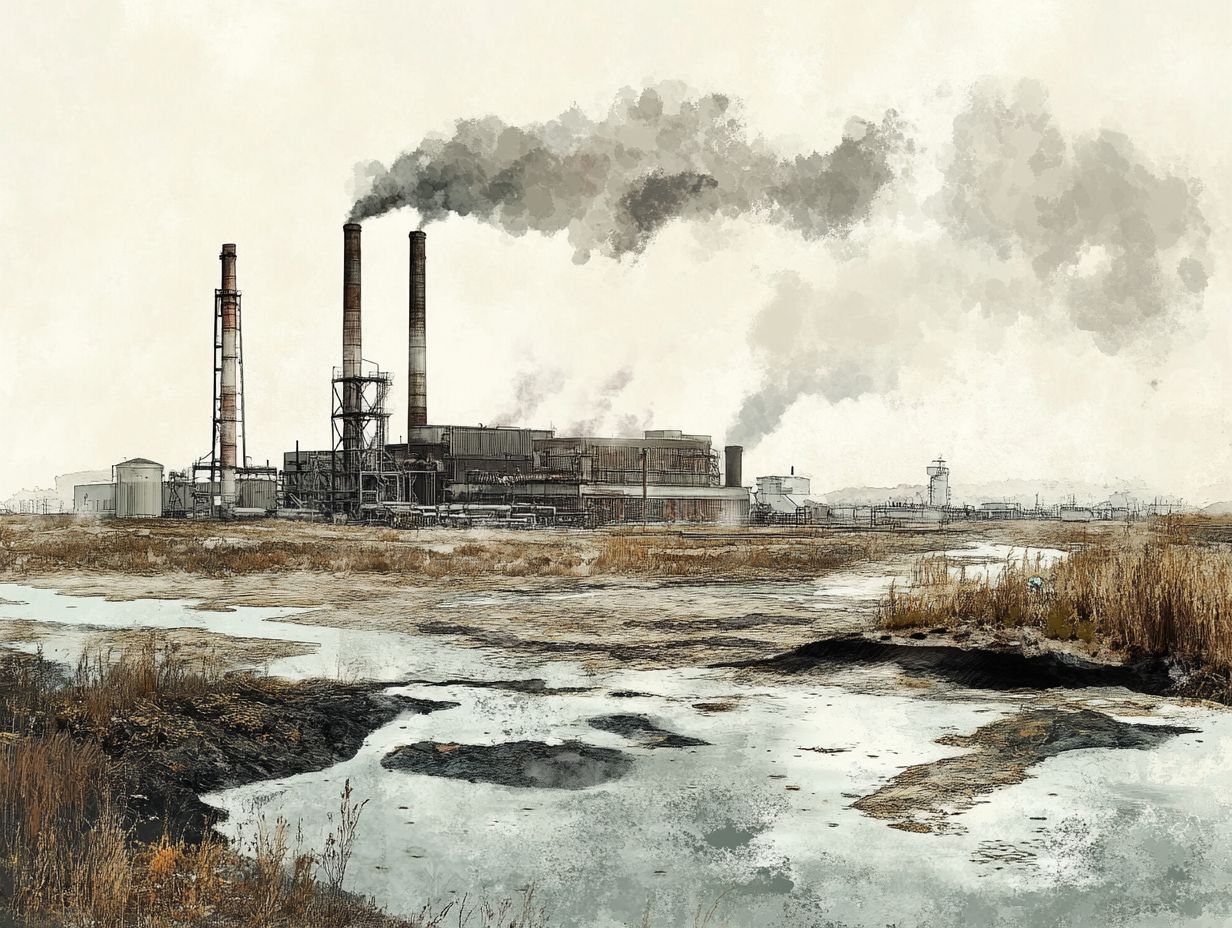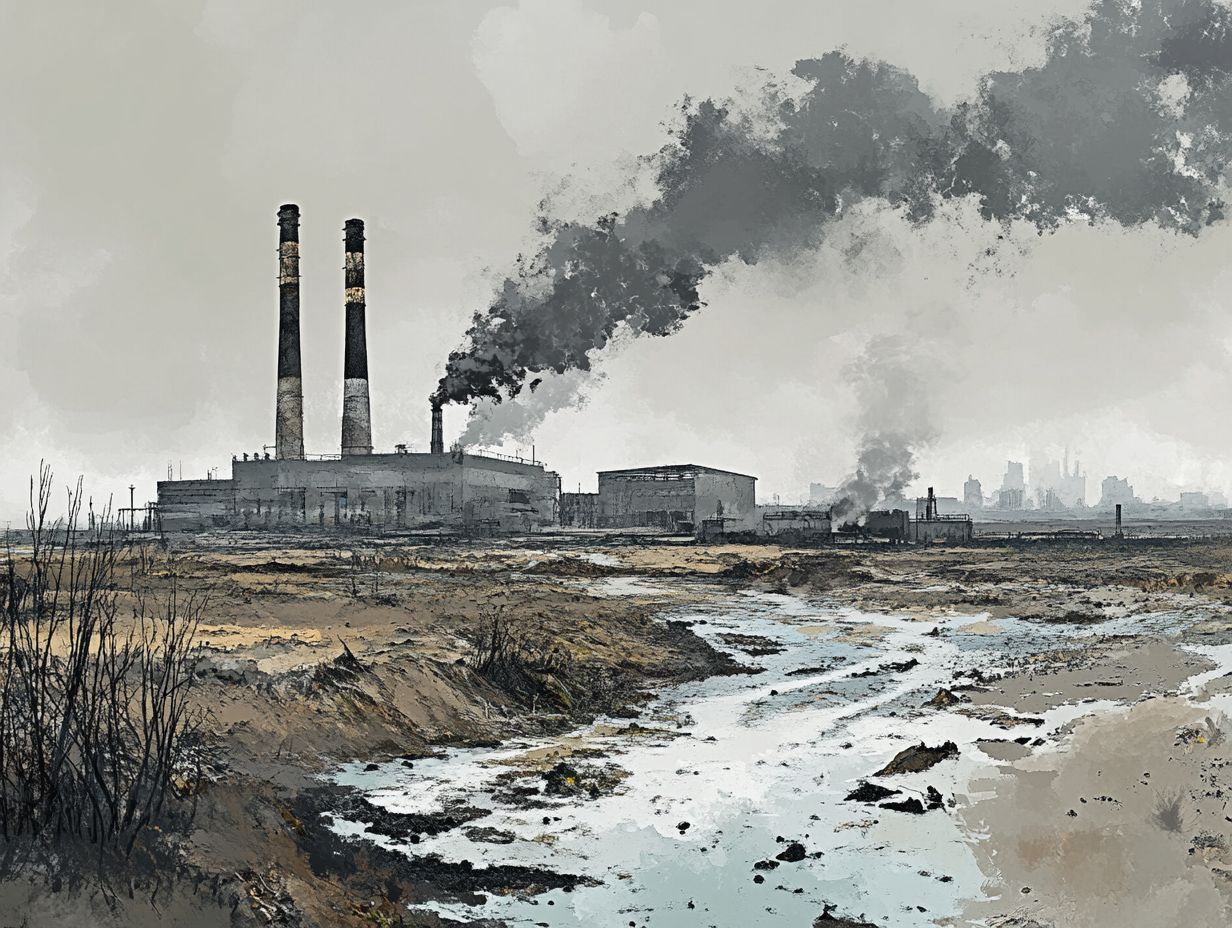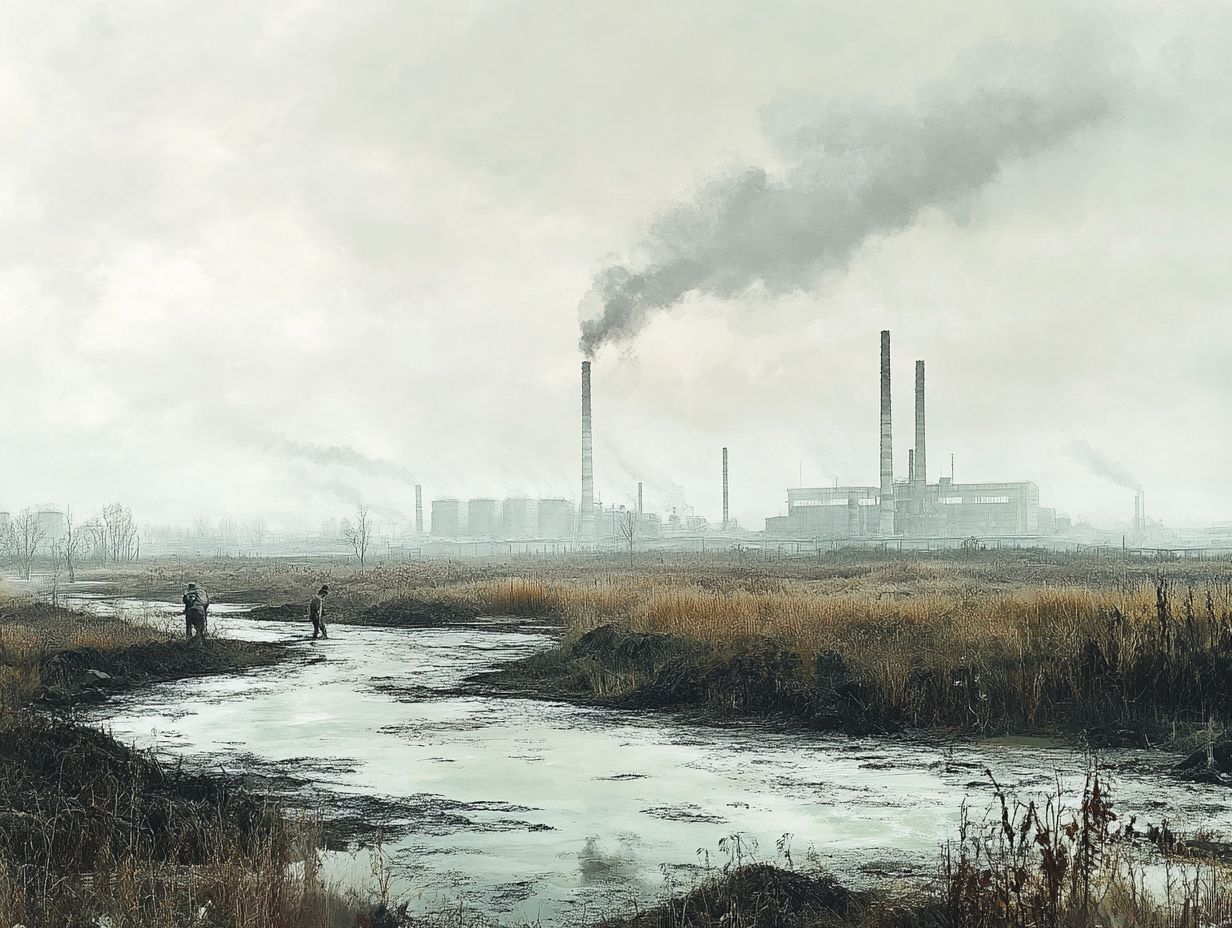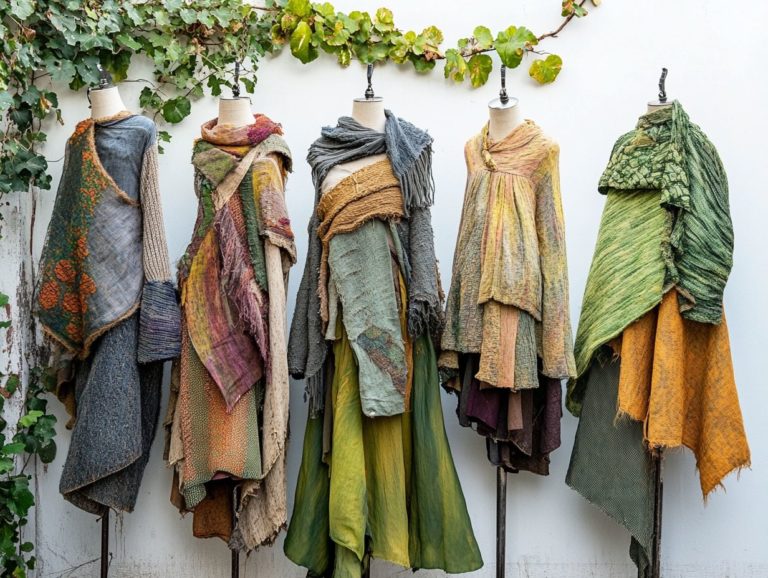The Environmental Impact of Textile Production
The textile industry, an essential pillar of the global economy, is under heightened scrutiny for its environmental impacts.
From water-intensive production processes to the harmful pollutants that make their way into ecosystems, the repercussions of textile manufacturing ripple far beyond the factory floor.
This exploration delves into the effects of textile production on water, air, and land, while also illuminating sustainable practices and consumer choices that can mitigate these challenges.
Discover the hurdles and solutions that are paving the way for a more sustainable future in fashion.
Contents
- Key Takeaways:
- The Textile Industry and Its Environmental Impact
- Water Pollution from Textile Production
- Land and Air Pollution from Textile Production
- Sustainable Solutions for Textile Production
- Consumer Actions to Support Sustainable Textile Production
- Making Informed Purchasing Decisions
- Frequently Asked Questions
- What is the environmental impact of textile production?
- How does textile production contribute to environmental pollution?
- What are some examples of environmental damage caused by textile production?
- What role do textile production practices play in environmental sustainability?
- How can consumers contribute to reducing the environmental impact of textile production?
- What are some initiatives being taken to address the environmental impact of textile production?
Key Takeaways:

- The textile industry has a significant environmental impact through its production processes, causing water, land, and air pollution.
- Water pollution from textile production is a major concern, with various causes and consequences on both the environment and human health.
- Consumers can support sustainable textile production by making informed purchasing decisions and advocating for reduced environmental impact in the industry.
The Textile Industry and Its Environmental Impact
The textile industry plays a significant role in environmental challenges, largely fueled by the fast fashion phenomenon, which has escalated textile pollution and resource consumption. Understanding the environmental impact of textile production is essential, as it encompasses intricate processes that lead to landfill waste, gases that contribute to climate change, and excessive water usage.
This industry, marked by its swift pace and consumer-driven trends, profoundly affects the ecosystem, underscoring the urgent need for sustainable practices. Embracing these practices is vital not only to mitigate the negative impacts on the environment but also to foster a circular economy that benefits all.
Overview of Textile Production Processes
Textile production is a complex journey, spanning from raw material extraction to the final product. This process plays a crucial role in shaping the textile lifecycle and its environmental impact.
At the outset, you have cotton farming, where intricate techniques come into play, significantly affecting land use and water resources. Once harvested, the cotton enters a processing phase that includes spinning and weaving, consuming substantial energy and water.
Then comes dyeing, a stage that introduces various chemicals; if mishandled, this can result in serious pollution of nearby waterways. The substantial waste generated during the manufacturing phase is a pressing concern. This highlights the necessity for sustainable practices.
Embracing strategies like clothing recycling and effective textile management not only helps reduce environmental harm but also fosters a circular economy that can greatly lessen the industry’s overall footprint.
Water Pollution from Textile Production
Water pollution is a pressing concern linked to textile production. This issue arises mainly from the heavy reliance on chemicals and the significant volumes of water consumed throughout the manufacturing process.
Causes and Consequences

The primary culprits behind water pollution in textile production are the discharge of wastewater that hasn’t been cleaned, excessive water usage, and the introduction of microplastics and harmful chemicals into water bodies.
The repercussions of these practices extend far beyond industrial zones, affecting both aquatic ecosystems and human health. In textile hubs of developing nations, such as Bangladesh, it’s not uncommon for untreated wastewater to flow directly into rivers, drastically diminishing fish populations that are crucial for local communities’ sustenance.
Case studies have shown that hazardous chemicals, including azo dyes and heavy metals, can accumulate in aquatic life, posing significant health risks for those dependent on this water for drinking and irrigation. We must urgently adopt eco-friendly textiles and advanced wastewater treatment processes, which can alleviate these environmental challenges and safeguard both biodiversity and public health.
Join us in making a difference. Choose sustainable fashion today!
Land and Air Pollution from Textile Production
Land and air pollution are significant challenges faced by the textile industry. These issues mainly arise from waste disposal practices and emissions during production.
Effects on Ecosystems and Human Health
Textile-related pollution affects ecosystems and human health. Chemical exposure and habitat destruction pose serious risks.
Research shows that dyes and heavy metals from textile processes often seep into waterways, endangering aquatic life and disrupting local food chains.
According to a study by the Environmental Protection Agency, over 700,000 tons of textiles are discarded annually. This results in harmful substances leaching into soil and groundwater, threatening biodiversity and posing health risks to communities that rely on these resources.
By embracing sustainable practices, such as using eco-friendly materials and cleaner manufacturing techniques, you can make a real difference! This shift leads to better public health and a healthier planet for everyone.
Sustainable Solutions for Textile Production
Implementing sustainable solutions in textile production is essential to reduce environmental impact, promote a circular economy, and ensure eco-friendly practices throughout the textile lifecycle.
This approach benefits the planet while enriching the industry by fostering innovation and responsibility at every production stage.
Reducing Environmental Impact

Reducing the environmental impact of the textile industry demands a collective effort from manufacturers, consumers, and policymakers to adopt sustainable practices and boost textile recycling rates.
You can make a meaningful difference by being intentional in your purchasing choices. Opt for brands that prioritize sustainability and ethical production.
Supporting companies that utilize organic materials and promote fair labor practices benefits the economy and helps lessen harmful environmental effects.
Increasing textile recycling initiatives can be transformative. Community programs, such as H&M’s garment collection scheme, have successfully diverted millions of tons of textiles from landfills.
Advocating for stronger environmental legislation, such as proposed Extended Producer Responsibility laws, encourages manufacturers to take responsibility for their products’ lifecycle, ultimately fostering a circular economy. To better understand how your choices impact this, consider exploring the impact of fast fashion on the environment. Your choices can contribute to a more sustainable future in the textile industry!
Consumer Actions to Support Sustainable Textile Production
Consumers hold a pivotal position in championing sustainable textile production. By making informed purchasing decisions and engaging in proactive measures like clothing donations and swaps, you can significantly contribute to a more sustainable future.
Making Informed Purchasing Decisions
Making informed purchasing decisions is essential for consumers who want to support sustainable fashion and move away from the damaging practices of fast fashion that harm our environment.
To navigate the world of clothing brands, research the options you re considering. Dive into their websites and look for transparency about how they source their materials and their labor practices.
Be proactive and check sustainability claims by seeking out certifications from reputable organizations. These lend credibility to what brands say. Prioritize eco-friendly textiles and focus on materials such as:
- Organic cotton
- Tencel
- Recycled fabrics
Watch for fast fashion red flags like suspiciously low prices or rapid product turnover. Recognizing these signals helps you make smarter choices that support ethical production.
Championing sustainable clothing benefits the planet and enables brands committed to transparency and responsible manufacturing.
Frequently Asked Questions
What is the environmental impact of textile production?

The environmental impact of textile production refers to the negative effects that textile manufacturing has on the environment. This includes pollution, waste generation, and depletion of natural resources.
How does textile production contribute to environmental pollution?
Textile production contributes to environmental pollution through the use of chemicals and dyes. It also releases wastewater and air emissions that can harm both human health and the environment.
What are some examples of environmental damage caused by textile production?
Examples of environmental damage from textile production include deforestation, depletion of water resources, and contamination of soil and water bodies. It also contributes to greenhouse gas emissions, which affect climate change.
What role do textile production practices play in environmental sustainability?
Textile production practices significantly impact environmental sustainability. Sustainable practices, such as using organic or recycled materials and implementing responsible waste management, help mitigate negative effects.
How can consumers contribute to reducing the environmental impact of textile production?
Consumers can reduce the environmental impact by choosing to buy from sustainable fashion brands, purchasing second-hand clothing, and disposing of clothing responsibly through recycling or donating.
What are some initiatives being taken to address the environmental impact of textile production?
Several initiatives address the environmental impact of textile production, such as using sustainable materials and promoting circular fashion. Many brands are also working to reduce their carbon footprint and implement sustainable practices.
Explore sustainable fashion brands today to make a difference!





